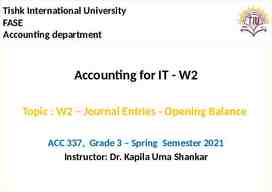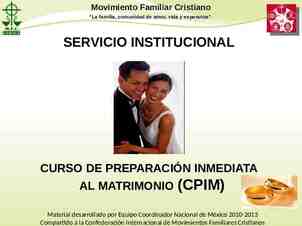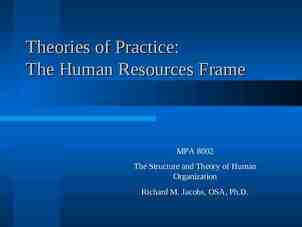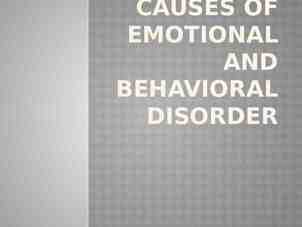Controlling as a Management Function Controlling A process
27 Slides86.00 KB
Controlling as a Management Function Controlling A process of monitoring performance and taking action to ensure desired results. It sees to it that the right things happen, in the right ways, and at the right time. 1
Controlling as a Management Function Controlling Done well, it ensures that the overall directions of individuals and groups are consistent with short and long range plans. It helps ensure that objectives and accomplishments are consistent with one another throughout an organization. 2
Controlling as a Management Function Controlling It helps maintain compliance with essential organizational rules and policies. 3
Controlling as a Management Function Cybernetic Control System One that is self-contained in its performance monitoring and correction capabilities. (thermostat) The control process practiced in organizations is not cybernetic, but it does follow similar principles. 4
The Control Process Establish objectives and standards. Measure actual performance. Compare results with objectives and standards. Take necessary action. 5
Establish Objectives and Standards The control process begins with planning and the establishment of performance objectives. Performance objectives are defined and the standards for measuring them are set. 6
Establish Objectives and Standards There are two types of standards: Output Standards - measures performance results in terms of quantity, quality, cost, or time. Input Standards - measures work efforts that go into a performance task. 7
Measuring Actual Performance Measurements must be accurate enough to spot deviations or variances between what really occurs and what is most desired. Without measurement, effective control is not possible. 8
Comparing Results with Objectives and Standards The comparison of actual performance with desired performance establishes the need for action. Ways of making such comparisons include: Historical / Relative / Engineering Benchmarking 9
Taking Corrective Action Taking any action necessary to correct or improve things. Management-by-Exception focuses managerial attention on substantial differences between actual and desired performance. 10
Taking Corrective Action Management-by Exception can save the managers time, energy, and other resources, and concentrates efforts on areas showing the greatest need. There are two types of exceptions: Problems - below standard Opportunities - above standard 11
Effective Controls The Best Controls in Organizations are Strategic and results oriented Understandable Encourage self-control 12
Effective Controls The Best Controls in Organizations are Timely and exception oriented Positive in nature Fair and objective Flexible 13
Types of Control Preliminary Sometimes called the feedforward controls, they are accomplished before a work activity begins. They make sure that proper directions are set and that the right resources are available to accomplish them. 14
Types of Control Concurrent Focus on what happens during the work process. Sometimes called steering controls, they monitor ongoing operations and activities to make sure that things are being done correctly. 15
Types of Control Postaction Sometimes called feedback controls, they take place after an action is completed. They focus on end results, as opposed to inputs and activities. 16
Types of Controls Managers have two broad options with respect to control. They can rely on people to exercise self-control (internal) over their own behavior. Alternatively, managers can take direct action (external) to control the behavior of others. 17
Types of Control Internal Controls Allows motivated individuals to exercise self-control in fulfilling job expectations. The potential for self-control is enhanced when capable people have clear performance objectives and proper resource support. 18
Types of Control External Controls It occurs through personal supervision and the use of formal administrative systems. Performance appraisal systems, compensation and benefit systems, employee discipline systems, and management-by-objectives. 19
Organizational Control Systems Management Processes Strategy and objectives Policies and procedures Selection and training Performance appraisal Job design and work structures Performance modeling, norms, and organization culture 20
Organizational Control Systems Compensation and Benefits Attract talented people and retain them. Motivate people to exert maximum effort in their work. Recognize the value of their performance contributions. 21
Organizational Control Systems Employee Discipline Discipline is defined as influencing behavior through reprimand. Progressive Discipline ties reprimand to the severity and frequency of the employee’s infractions. Positive Discipline tries to involve people more positively and directly in making decisions to improve their behavior. 22
The “Hot Stove Rule” To be Effective Discipline Should be: Immediate Informative Focus on activity not personality Consistent Occur in a supportive setting Support realistic rules 23
Organizational Control Systems Information and Financial Activity-based costing - the true cost of all products and services. Economic value added - examine the value added by all activities. Understand the implication of key financial measures of (ratios) organizational performance 24
Operations Management and Control Purchasing Economic Order Quantity automatic reorder points Just-In-Time Scheduling 25
Operations Management and Control Project Management Program Evaluation and Review Technique (PERT) - Identifies and controls the many separate events in complex projects. 26
Operations Management and Control Statistical Quality Control Based on the establishment of upper and lower control limits, that can be graphically and statistically monitored to ensure that products meet standards. 27
































